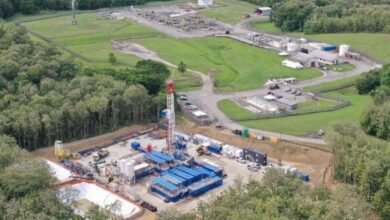Craighead: E&P in ultra-deepwater is like ‘going to mars’
By Joanne Liou, associate editor

In the not so distant past, with deepwater exploration still in its infancy, the fear of shrinking oil and gas supplies frequently ran high. Today, however, industry has embraced the challenges of deepwater and continues to push beyond to ultra-deepwater. “We live in a world where we now see a future field with energy prosperity,” Baker Hughes president and CEO Martin Craighead stated at the International Petroleum Technology Conference in Beijing in late March. “There are two primary drivers of this new prosperity: unconventionals and deepwater.”
Addressing the latter, Mr Craighead focused on ultra-deepwater, likening E&P in that frontier segment to reaching the moon. “Today, our customers are asking us to help them solve problems of the ultra-deep frontier, which is so much more challenging and exciting. It’s like going to Mars.”
Baker Hughes is working with 10 customers who collectively intend to drill approximately 300 deepwater wells over the next decade in the GOM, representing about $30 billion initially to extract resources from the Lower Tertiary, Mr Craighead explained. Technology breakthroughs associated with completions and sustained production from frontier targets, such as the Lower Tertiary and Jurassic formations, will be key to industry’s success. “Engineering excellence and innovation and outmost reliability here, I believe, will be potentially rewarded far greater than anywhere our industry has ever worked before.” According to a Baker Hughes customer, a 1% improvement in recovery on some projects can translate into an additional $3.2 billion, Mr Craighead stated.
With approximately 45 active rigs, 11 of which entered the region over the past year, the GOM remains the fastest-growing deepwater market in the world, he said. “An additional three or four will be commissioned this year, and moving from traditional deepwater to the ultra-deep frontier holds both great challenges, as well as great potential prosperity, if those challenges can be met.”
The formations are consolidated, and with reservoir pressures exceeding 30,000 psi and temperatures ranging from 350°F to 400°F, large stimulation treatments will be required to establish reservoir productivity. “In fact, stimulations in the Lower Tertiary projects must be carried out across multiple zones; some particular cases covering as much as 3,000 ft of vertical reservoir,” Mr Craighead said. “In addition, each zone will require up to half a million pounds of proppants.”
Further, the wells face a high risk of unwanted solids, which can damage completion systems, compromising its reliability. “Every component in these systems must be designed to a whole new level of reliability,” Mr Craighead said. Operators are requiring fully redundant subsea and well boosting systems, for example, with a life expectancy in excess of 10 years, he added.
Electrical submersible pumps (ESPs) have been operating reliably in deepwater environments for years, but the next frontier will require these ESPs to run in HPHT conditions and sit idle for as long as five years before activation. “Once it’s turned on, it better work and work for a long time,” Mr Craighead said.
The ESP system must be fully compatible with the well completion hardware, which will have its own set of complexities in the ultra-deepwater environment. “The laws of physics are forcing us to re-engineer highly complex systems that have typically been designed for the dry environment. Each component of these innovative intelligent production systems must be waterproof like never before and designed to withstand the pressures that come with 10,000 ft of water.”
Well depths and operating conditions will also challenge fiber-optic technology. To connect upper and lower completions and provide continuous automation downhole, two fiber-optic streams must precisely align – each thinner than a strand of hair – and maintain the photon productivity over the entire length of the wellbore, Mr Craighead explained. “The price at stake in this new frontier, nevertheless, is enormous.”




